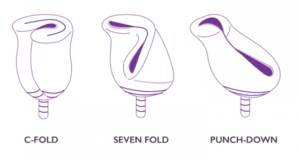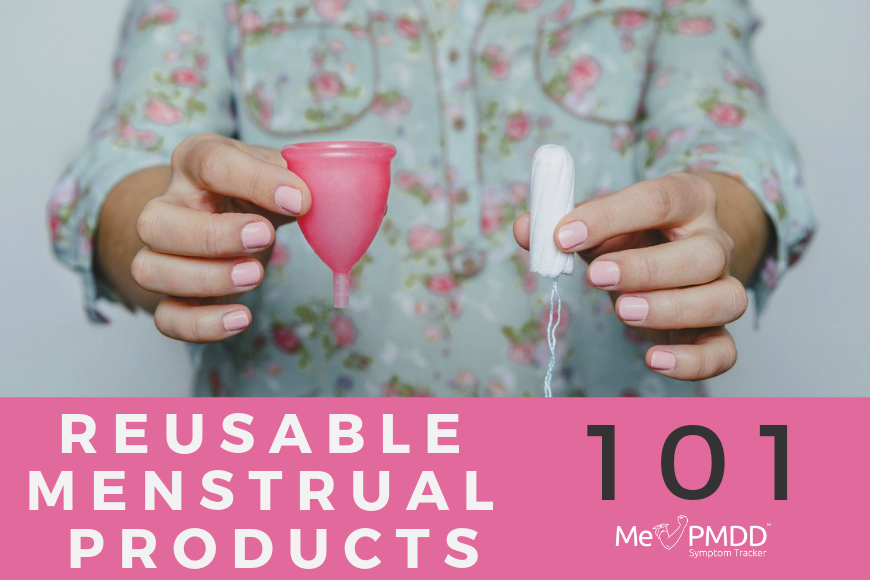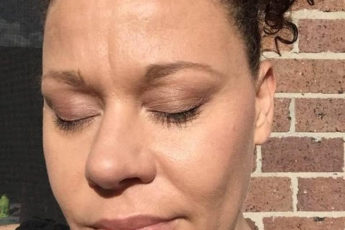By Ms. Menses
It’s amazing how many menstrual product options are available today.
Fifty years ago, women were using strips of cloth from the scrap box. Thirty years ago, we only had about five options of pads with adhesive to stick and hold them in place, and only a few types of tampons to choose from. Today, we have twenty different tampon options that range from sport to teen to heavy, with plastic applicators, cardboard applicators, or none at all. Disposable pads now come in cute prints with fashionable wrappers, available in an array of sizes, shapes, and absorbency levels.
Unfortunately, in the process, we went from breathable, cotton strips of cloth to highly processed, synthetic, disposable pads and tampons that are full of chemicals like Glyphosate, Chlorine, and artificial fragrances. Thankfully, in the last five years, more and more companies have started making healthier, organic, and eco-friendly menstrual products. We now have tampons made from organic cotton and natural fibers, reusable cloth pads, menstrual cups, sea sponges, and menstrual underwear.
Health concerns
Choosing chemical-free, reusable, menstrual products can provide many health benefits and mitigate the health risks that come from traditional tampons and pads.
Chemical-laden tampons can cause cervical cancer, Toxic Shock Syndrome, and many other conditions. Disposable pads have synthetic materials like rayon which can absorb all the moisture in your vagina, creating an increased risk for infections and increasing those horrible cramps. The fibers in disposable pads are bleached with chlorine dioxide which creates dangerous byproducts that remain in our systems for decades. These synthetic chemicals can lead to hormone disruption and even disorders like endometriosis.
There are many negative consequences when it comes to the chemicals in traditional disposable pads and tampons and many positive benefits of chemical-free products. Chemical-free menstrual products can lead to shorter and more regular periods and reduce menstrual cramps. You might experience lighter periods with less bloating and even experience less PMS-related mood symptoms.
Cost
As a college student myself, using reusable products has been a lifesaver financially. Why spend $6 to $20 every month when you can buy a cup or a set of cloth pads for $25 and only replace them after months or years of use? You can even make your own cloth pads from fabric scraps, cutting the cost entirely. Making your own pads or having them custom made is an excellent option for people who would like a particular shape or design. For example, if you like to exercise but find your pad slipping, or have a petite figure but want more absorption, a custom made pad is an excellent choice for you. Buying disposables seems like such an unnecessary expense to me now. Switch to reusable menstrual products, and, like me, you might never go back!
Reusable Cloth Pads
It may seem like a hassle to have to wash your pads every month, but this hassle is far outweighed by the benefits of reusable cloth pads. Cloth pads come in many different shapes, sizes, and materials. You can buy pads that are smaller, thinner, or wider to fit the shape of your body. You can find pads with prints from your favorite movies or pop culture references so that menstruating, I dare say it, can become fun. Making your own cloth pads is also an easy process with the availability of cloth stores nearby. Or, you could choose to support local women on Etsy or other stores/websites by buying their products.
Cloth pads last a long time and are very comfortable. Imagine choosing between the feel of soft cloth on your most sensitive area versus a plasticky disposable pad. No more crinkling or having a bulge in your underwear! Cloth pads don’t chafe or cause rashes. They fit seamlessly into your underwear and make moving around easier and more comfortable. Cloth pads do not smell because there are no chemicals. They’re also are a great choice to save money and be healthy if you don’t want to insert a menstrual cup.
Changing your pad
To change your pad, keep a small bucket filled with soapy water near your toilet at home, along with your clean cloth pads at arms’ reach. Remove the used pad from your underwear and place in the bucket. If you are away from home (at work, school, etc.), bring a bag with a few clean cloth pads and another bag (Ziploc bag) to put the used pads in. When you go to a public restroom, simply bring these bags with you, fold up the used pad and place it in the Ziploc bag. When you come home, you can place the used ones in the bucket of soapy water. At the end of your cycle, dump out the bucket of water and throw your cloth pads into your washing machine with your dirty clothes and wash like you normally would. It’s as easy as doing laundry.
Menstrual Cups
Menstrual cups have really caught on in the past few years, especially with the millennial crowd. They come in many different shapes and sizes to accommodate anyone. They can be made out of different materials like silicone, rubber, or TPE (Thermo Plastic Elastomer) if you have a latex allergy. Find one that is comfortable and safe for you.
There are many advantages to using a menstrual cup. Menstrual cups have an initial cost, but after that, you can get up to 5 years of use with no waste or additional cost. You just boil your cup after each cycle, and you are ready to go. Even better, they don’t smell! The blood doesn’t come into contact with the air, so you don’t have any embarrassing odors. Cups also maintain proper vaginal pH balance and healthy bacteria in your vagina, unlike disposable pads and tampons. One of my favorite things about menstrual cups is that you don’t have to dump it or change it as often as you would with disposable. You can go up to 12 hours without messing with it, depending on how heavy you are and the capacity of your cup. It is also possible to have sex with your cup in if you so choose. After you get used to it, menstrual cups are actually quite easy to use, as simple as inserting and removing a tampon, and you shouldn’t feel it at all.
The biggest downfall is that inserting a menstrual cup means you have to get a bit up close and personal with your vagina. There can be a learning curve with inserting the cup the first few times, especially for young girls. Emptying the cup can also be messy at first. But you will get the hang of it and figure out what works best for you.
Finding the right cup for you
Size
To find the best fit for your menstrual cup, take some time to get to know your vagina while on your period to see how long you need your cup to be. Insert your finger in your vagina and see how deep your finger goes before you hit your cervix. Your cervix feels a little bit like the tip of your nose. If you can’t feel your cervix easily, you can use a longer cup. If you have never had sex, a smaller cup will probably fit better. If you have a dropped cervix, MeLuna has ‘Shorty’ cups that will work better for you, shorter but wider so your cervix can sit in the cup. If you are into sports and in good shape, you will want a firmer cup. If you are sensitive and have bad cramps, a softer cup may be better. Soft cups are not recommended for first-timers as they will not pop open as easily and may cause more leakage if not fully in place or open.
The Stem
One other thing that is important to note when purchasing a menstrual cup is the stem. The stem can be a post, a flat wedge, a ring, a ball, or nothing but ridges on the bottom of the cup. I think all beginners should choose a cup with a ring. It makes the cup much easier to remove and hang onto when wet and slippery. All menstrual cups have little air holes underneath the rim. This aids in creating suction to minimize leaking. It also helps in removing the menstrual cup. You should make sure that when you clean the cup none of the holes are clogged.
Inserting your cup
Inserting your cup for the first time is a bit scary. But with practice, you will become a pro. For the first few times you use a menstrual cup I would wear a panty liner in case your cup isn’t sitting quite right or didn’t open up fully. It’s a learning process, so be patient with yourself while you get the hang of it. It is also better to try your cup for the first time when you are not on your period. This will reduce the stress and mess while you are figuring it all out. I also recommend trying it out in the shower when everything is wet, and you are relaxed. You are just practicing insertion and removal.
To insert the cup, first, make sure your hands and cup are freshly washed. Then fold your menstrual cup so it is smaller and can be inserted easily like a tampon. There are multiple folds you can use to insert. The C fold is the most common, the punch down is supposed to be the easiest to open, but my favorite is the 7 fold. It really is up to you… try them all and see which one suits you best. There are also a bunch of youtube videos that can show you how to fold your cup to help. Once you have your cup folded, squat down and insert the cup at a 45-degree angle towards your spine, until the stem is in. Your cup should pop open fully and create suction. You can make sure it popped open by running your finger around the rim or twisting the cup a little. Next, squeeze your Kegel muscles a few times to settle it into place. If the cup is not in place just remove it and try again. Your cup does not have to sit up high. If it is too high, it will make removal more difficult. The stem should be just inside the vaginal opening, not sticking out either. Another trick you can use is just to insert the tip and then help it pop open just inside the vaginal canal, then guide it up a little into position. If you have a low cervix and the post is hanging out irritating your labia, you can trim or remove it altogether. Try only trimming a little at a time until you get your perfect fit and length.

Emptying your cup
While emptying your cup can be a bit messy at first, you’ll quickly get the hang of it. It is advisable to sit towards the back of the toilet seat, so you don’t make a mess. When emptying your cup never just pull on the stem. It is best to pinch the base of the cup to release suction and gently rock the cup out. To lower your cup for easier removal bear down on your kegel muscles like you are going number 2 or coughing. If you’re struggling to get it out, no need to panic! Remember, you can never LOSE your cup. If you truly can’t get your cup out, use the end of a spoon to catch the edge and break the suction to remove it.
Cup Maintenance
Cup maintenance is actually pretty simple. When removing your cup, set a few folds of toilet paper by your toilet or sink if you need to set it down. Simply wash your cup with a gentle soap like babies soap or hand soap and then reinsert. You can use a water-based lubricant to assist insertion, coconut oil, or plain water. After your cycle is over boil your cup to sterilize it and store in its cotton pouch until your next period.
Cleanup
Many women don’t want to have to clean their own pads or cup due to lack of time or the “gross” factor. However, there is nothing inherently gross about menstrual blood. I’ve found that coming into contact with my blood and washing my own pads, even by hand sometimes, is a beautiful process into knowing my body and being proud of it. Wearing reusable products may be your first step towards loving yourself more and not being ashamed of menstruation. Take a vote for the menstrual movement and try out reusable products. Your body will thank you.
About the Warrior
Ms. Menses is a university student who is passionate about menstruation and women’s rights. She has done a TED Talk about menstruation and is currently working on researching the effects of menstruation on girl’s education. She loves to talk about and teach classes about menstruation. She is planning on getting a Master’s in Public Health with a focus on Women’s Reproductive Health issues. She hopes to help make menstruation something people can talk about openly so that girls do not have to suffer.



